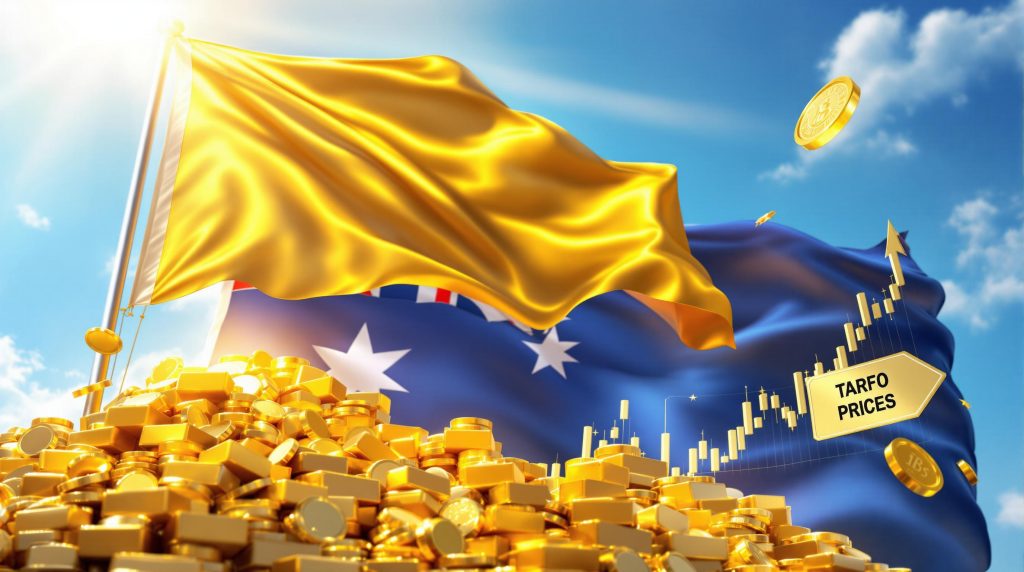What Are US Gold Tariffs and Why Do They Matter for Australian Investors?
The global gold market is experiencing a significant shift as the United States implements new tariffs on imported gold. These trade measures are creating ripples through international commodity markets, potentially altering supply chains, pricing dynamics, and investment strategies worldwide. For Australian investors with exposure to ASX-listed gold stocks, understanding how US gold tariffs could impact ASX-listed gold stocks is crucial for portfolio positioning.
Gold has traditionally served as a safe-haven asset during economic uncertainty, a hedge against inflation, and a portfolio stabilizer. However, the introduction of US tariffs adds a new variable to this equation, potentially creating both challenges and opportunities for Australian gold producers.
Understanding the US Gold Tariff Decision
The tariff announcement specifically targets certain gold imports, with particular focus on refined gold products from Switzerland. The policy affects gold bars weighing one kilogram or 100 ounces, subjecting them to a substantial 39% reciprocal tariff. This decision carries significant weight considering Switzerland's position as a major gold refining hub, processing approximately 70% of the world's gold according to Swiss Federal Customs Administration data.
The Strategic Rationale Behind the Tariffs
While official statements remain limited, market analysts suggest several potential motivations behind the tariff implementation:
- Strengthening domestic refining capabilities
- Reducing dependency on specific foreign suppliers
- Creating leverage in broader trade negotiations
- Demonstrating commitment to protecting American manufacturing jobs
- Securing supply chains for strategic commodities
Note: The tariff implementation represents one of the most significant policy interventions in the gold market in recent decades, potentially redirecting billions in trade flows.
How Have Global Gold Markets Responded to the Tariff News?
Immediate Price Movements
The market reaction to the tariff announcement was swift and substantial. Gold futures on COMEX surged to record highs, demonstrating how quickly policy announcements can impact precious metals markets and, by extension, the equities of companies operating in the sector.
Spot gold prices similarly experienced sharp upward movement, driven by both fundamental supply concerns and speculative positioning. Traders rushed to capitalize on potential supply disruptions, creating a temporary price surge that contributed to the gold market surge.
Subsequent Market Volatility
Following the initial spike, markets experienced a notable correction phase. Gold futures retreated while spot prices eased as traders reassessed the long-term implications and unwound some speculative positions.
Even after the initial reaction settled, market participants remained cautious about further potential disruptions, highlighting the sustained uncertainty that US tariff policies can introduce to commodity markets.
Price volatility indicators:
- Increased trading volumes across major gold exchanges
- Widened bid-ask spreads in spot markets
- Enhanced options pricing volatility
- Heightened activity in gold ETFs
What Are the Broader Implications for Global Gold Supply Chains?
Reshaping International Gold Flows
Gold supply chains are inherently global, connecting mines in countries like Australia, South Africa, and Peru with refineries in Switzerland, India, and the United States. The implementation of tariffs could trigger significant changes in how refined gold moves around the world.
Countries facing higher tariffs may redirect their supply toward alternative markets in Asia and Europe, potentially creating new opportunities for Australian producers to fill supply gaps in regions affected by tariff-related disruptions.
Price Impact Assessment
While tariffs may provide an initial boost to gold prices, the sustainability of any price increase depends on how efficiently markets adapt. If global supply chains quickly establish new equilibrium points, price pressures could moderate. However, in the current environment of heightened inflation sensitivity and interest rate uncertainty, even temporary price movements can significantly affect mining profitability.
According to the gold price forecast for coming years, analysts project continued strength based on both geopolitical tensions and economic fundamentals.
Physical Gold vs. Gold Equities
It's worth noting the distinction between physical gold and gold mining stocks. Physical gold prices tend to respond more directly to supply disruptions, while gold equities are influenced by a broader range of factors including:
- Spot gold prices
- Production costs and efficiency
- Company-specific growth prospects
- Debt levels and financial health
- Jurisdiction risk and political stability
An ASX-listed gold producer with low all-in sustaining costs (AISC) could potentially see margin expansion beyond what the spot price movement alone might suggest, particularly if its customer base is concentrated in non-tariffed regions.
Which ASX Gold Stocks Could Benefit Most From US Tariffs?
Potential Winners in the Australian Gold Sector
Several characteristics may position certain ASX-listed gold miners to benefit from the current tariff environment:
-
Producers with diversified export markets: Companies with established sales channels across multiple regions can more easily redirect supply if needed.
-
Low-cost operators: Miners with all-in sustaining costs (AISC) significantly below the current gold price stand to benefit most from any sustained price increases.
-
Companies with strong Asian market connections: Australian producers with established relationships in Asian markets could capitalize on supply chain shifts.
-
Miners with advanced processing capabilities: Companies able to produce high-purity gold products may find new opportunities if refining bottlenecks emerge elsewhere.
Major ASX-listed producers with diversified operations and established market relationships could potentially benefit if global supply routes shift in response to tariffs, though any advantages would depend on sustained price changes rather than temporary volatility.
| Producer Category | Typical AISC (AUD/oz) | Potential Tariff Benefit |
|---|---|---|
| Large diversified producers | $1,350-1,550 | Moderate-High |
| Mid-tier focused producers | $1,450-1,750 | Moderate |
| Small single-mine operations | $1,550-1,950 | Low-Moderate |
| Developers/Explorers | N/A | Indirect |
Potential Challenges for Some ASX Gold Stocks
Not all Australian gold miners are equally positioned to benefit from the current situation:
-
Producers heavily dependent on US markets: Companies with significant direct exposure to US buyers could face more complex trading conditions.
-
High-cost operators: Miners with AISC close to current gold prices may see limited benefit from price volatility if it's accompanied by increased operational uncertainty.
-
Junior explorers without production: Pre-production companies may find it more difficult to secure favorable financing or offtake agreements in an environment of heightened uncertainty.
-
Companies with inflexible sales arrangements: Miners locked into rigid sales contracts may be unable to capitalize on emerging opportunities in alternative markets.
How Should Investors Approach ASX Gold Stocks in This Environment?
Strategic Positioning in Gold Equities
For investors seeking exposure to potential tariff-related benefits, several approaches merit consideration:
-
Gold miner ETFs: Exchange-traded funds like VanEck Vectors Gold Miners ETF (ASX: GDX) that include a basket of gold producers can provide diversified exposure to the sector, potentially capturing upside from both price movements and production efficiencies.
-
Low-AISC producers: Direct investment in miners with industry-leading cost structures offers leveraged exposure to any sustained gold price increases.
-
Companies with growth pipelines: Producers with near-term production expansion plans could see enhanced project economics if higher gold prices persist.
In addition, implementing effective gold investment strategies can help maximize returns in this evolving market environment.
Investment perspective: "The tariff situation creates a dual opportunity – both in potential price appreciation for physical gold and margin expansion for well-positioned producers with flexible supply chains and strong cost controls."
Balancing Risk Through Diversification
While gold is traditionally viewed as a defensive asset, investors should consider:
-
Commodity diversification: Combining gold exposure with other commodities such as copper or battery metals could provide balance if tariff impacts prove temporary.
-
Geographic diversification: Including gold producers with operations across multiple jurisdictions helps mitigate country-specific risks.
-
Market cap diversification: Balancing investments across large, mid, and small-cap gold stocks can provide exposure to different growth and risk profiles.
Understanding the gold stock guide that explains secular cycles can help investors make more informed decisions about timing their market entries and exits.
Short-Term vs. Long-Term Considerations
Tariff announcements can create momentum-driven trading opportunities in both physical gold and mining equities. However, long-term investors should remain focused on fundamental drivers such as:
- Global monetary policy directions
- Central bank gold purchasing trends
- Real interest rate environments
- Production cost curves across the industry
- Company-specific operational excellence and growth potential
What Key Metrics Should Investors Monitor?
Critical Indicators for ASX Gold Stock Assessment
When evaluating potential investments in the gold sector during this period of tariff-induced uncertainty, several metrics deserve particular attention:
-
All-in sustaining costs (AISC): This comprehensive measure of production costs provides insight into a company's profit margins at various gold price points.
-
Net cash position: Companies with strong balance sheets can better weather volatility and potentially capitalize on acquisition opportunities.
-
Production growth profile: Miners with clear pathways to increased production may offer better leverage to sustained higher gold prices.
-
Geographic diversification of sales: Companies selling to multiple markets may demonstrate greater resilience to trade policy changes.
-
Hedge book status: The extent to which a producer has pre-sold future production at fixed prices affects its exposure to current market movements.
According to analysis from VanEck Australia, tariffs could significantly alter gold supply chains and create opportunities for investors who understand the new market dynamics.
Technical analysis metrics to consider:
- 50-day and 200-day moving averages for both gold prices and individual stocks
- Relative strength indicators comparing gold equities to physical gold performance
- Volume patterns during price movements to assess conviction levels
- Support and resistance levels from previous gold price cycles
What's the Long-Term Outlook for ASX Gold Stocks?
Beyond the Immediate Tariff Impact
While tariffs have created short-term market reactions, several longer-term factors will likely determine the performance of ASX-listed gold stocks:
-
Central bank gold buying trends: Continued purchasing by global central banks could provide sustained support for gold prices.
-
Real interest rate environment: The relationship between nominal interest rates and inflation remains a fundamental driver of gold performance.
-
Currency movements: The Australian dollar's strength or weakness relative to the US dollar can significantly impact local gold producers' profitability.
-
Industry consolidation potential: Higher gold prices could accelerate merger and acquisition activity in the sector.
-
Production cost inflation: Rising input costs for energy, labor, and materials could offset some benefits of higher gold prices.
Frequently Asked Questions About US Gold Tariffs and ASX Stocks
How does the Australian dollar impact ASX gold miners?
Currency movements play a significant role in Australian gold producer profitability. A weaker Australian dollar relative to the US dollar (in which gold is typically priced) can amplify the benefit of higher gold prices for local miners. Conversely, a strengthening AUD can partially offset gains from rising gold prices.
This currency effect essentially provides a natural hedge for Australian producers during periods of economic uncertainty, as the AUD often weakens when global risk aversion increases. Historically, a 10% decline in the AUD/USD exchange rate can improve margins by approximately 8-12% for the average Australian gold producer.
Can ASX gold stocks benefit from US tariffs without direct US exposure?
Yes, Australian gold miners can potentially benefit indirectly from tariff-related market disruptions even without selling directly to the US market. If tariffs cause global supply chain realignments, Australian producers could find new opportunities in markets seeking alternative sources.
Additionally, if tariffs contribute to higher global gold prices, all producers benefit from improved margins, regardless of their specific customer base. Low-cost, financially robust producers with diversified sales channels are best positioned to capitalize on such market shifts.
Are gold ETFs a better option than individual stocks in this environment?
Gold ETFs offer diversified exposure to the sector, reducing company-specific risks while still providing leverage to gold price movements. For investors uncertain about which individual companies might benefit most from tariff-related market changes, ETFs can provide broader sector exposure.
However, carefully selected individual stocks may offer greater upside potential if you can identify companies with superior cost positions, growth prospects, and operational excellence. The optimal approach depends on an investor's risk tolerance, market knowledge, and investment time horizon.
Comparison of investment approaches:
| Approach | Risk Level | Potential Return | Best For |
|---|---|---|---|
| Physical gold | Lower | Moderate | Capital preservation |
| Gold ETFs | Moderate | Moderate-High | Diversified exposure |
| Major producers | Moderate-High | High | Growth & income |
| Junior miners | Very High | Very High | Speculative growth |
Will tariff effects on gold prices be sustained long-term?
While tariff announcements can trigger sharp price movements, their long-term impact often moderates as markets adapt. Supply chains adjust, alternative trading relationships develop, and initial price dislocations tend to normalize.
Over the longer term, fundamental factors such as global monetary policy, inflation trends, real interest rates, and central bank purchasing behavior remain the primary drivers of gold prices. Tariffs may accelerate certain market trends or create temporary advantages for specific producers, but they rarely override these broader economic forces indefinitely.
How might gold mining costs be affected by global trade tensions?
Broader trade tensions, including tariffs across multiple sectors, could potentially increase input costs for gold miners. Equipment, chemicals, energy, and other materials used in mining operations may become more expensive if subject to tariffs or supply constraints.
This could partially offset the benefits of higher gold prices. Companies with operations in multiple jurisdictions, vertical integration, or long-term supply contracts may be better insulated from such cost pressures. Investors should monitor both revenue (gold price) and cost implications when assessing the net impact of trade policies on mining profitability.
Practical Investment Strategies for Different Market Scenarios
If Gold Prices Stabilize at Higher Levels
If tariff-related disruptions lead to a new, higher equilibrium price for gold, investors might consider:
- Increasing allocation to producers with significant organic growth potential
- Focusing on miners with fixed-cost structures that benefit from margin expansion
- Looking for companies with exploration upside that becomes more valuable at higher gold prices
- Considering royalty companies that provide leveraged exposure to price increases without operational risks
If Volatility Persists Without Clear Direction
During periods of sustained uncertainty and price volatility, consider:
- Staggered entry points into preferred positions rather than lump-sum investments
- Options strategies to capitalize on increased implied volatility
- Emphasizing producers with financial flexibility to weather fluctuations
- Balancing physical gold holdings with equity positions to moderate overall portfolio volatility
If Tariff Impacts Prove Temporary
Should markets quickly adapt to tariffs with minimal long-term price impact:
- Focus on companies with superior operational execution regardless of gold price
- Prioritize producers with the lowest quartile cost positions in the industry
- Consider counter-cyclical investments in development-stage companies with strong projects
- Maintain disciplined position sizing to manage downside risk
Disclaimer: The information provided in this article is for general informational purposes only and should not be considered as investment advice. Gold prices and mining stocks can be highly volatile, and tariff impacts remain speculative. Investors should conduct their own research and consult with a qualified financial advisor before making investment decisions.
Looking to Capitalize on the Next Major Gold Discovery?
Ensure you never miss the market-moving announcements that could transform your investment portfolio by leveraging Discovery Alert's proprietary Discovery IQ model, which delivers real-time notifications on significant ASX mineral discoveries. Visit Discovery Alert's dedicated discoveries page to understand how historic gold and mineral discoveries have generated substantial returns for early investors.




